hpdz.net
High-Precision Deep Zoom
Animations
Take5
Deep-zoom into a fiber near a period-5 mini-brot
The fractal data for this video was generated way back in May 2008, but at that time, the software could not colorize it attractively, and this project got put on hold for a while. The new colorizing method on Project17 worked so well that I thought I would modify it a bit and try it out on this video, and that new modified method debuts here with very nice results. (See the Colorizing section below for details.)
Another delay in getting this video published was the music. I wanted something with a 5-beat rhythm, to match the 5-fold symmetry of the fibers in this animation, which meant no off-the-shelf piece would do, since 5-beat music is quite uncommon. The music for this video was meticulously crafted beat-by-beat using Sony ACID Pro 6.
Some random thoughts on the cosmic meaning of five-fold symmetry are below.
 |  |  |  |  |
 |  |  |  |  |
| MP4 Files (QuickTime player) | |
|---|---|
| Fast Download | 320x240 200 Kbps 5.3 MB fast start |
| Good Quality | 640x480 2 Mbps 30 MB fast start |
| High Quality | 640x480 4 Mbps 97 MB fast start |
| WMV Files (Windows Media Player) | |
| Fast Download | 320x240 200 Kbps 6.9 MB |
| Date Generated: | 4-5 May 2008 |
| Final Image Size: | 2.8e-47 |
| Resolution: | 640x480 |
| Video Length: | 2:40 of fractal, 3:08 overall |
| Frames: | 4800 |
| Rendering Time: | 22.5 hours |
| Method: | plain old fractal counts |
| Audio: | Custom composition with ACID Pro 6 |
Colorizing
The coloring of this animation was done with a global rank-order method. This is similar to the global histogram method that was used for Project17, but instead of using a histogram of the fractal data, which takes into account the frequency of each fractal data value when determining how to color it, this approach uses a rank-order list, which only is concerned where each data value places in the list of all fractal data values in the whole video. This balances the colors evenly, like the histogram method does, but it avoids the flattening of the color mapping that is evident at the end of Project17.
A more detailed discussion of these two methods as they apply to still images is in the Technical section. The same underlying concept has been generalized to videos for Take5 and Project17.
Five-Fold Symmetry
Something about five-fold symmetry resonates in the human mind in a way unlike any other geometrical configuration. Triangles and squares seem too simple, hexagons too regular, and septagons and beyond are too complex. Our minds experience five with a sort of tension, partly accepting it, partly rejecting it, which is perhaps why we hear five-beat rhythms as 2+3 or 3+2 rather than just as a group of 5 (or more commonly, as 10 in the form of 3+3+2+2, like in the music accompanying this video, and the music of Mission Impossible).
Nature itself is frustrated with five-fold symmetry: the pentagon cannot cover flat surfaces, but it can make very stable three-dimensional shapes.
Geometry
Of course, the pentagon is the most elementary shape with five-fold symmetry, and the pentagram, or five-pointed star, is very similar.
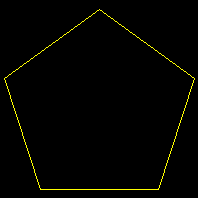
Pentagons are the simplest geometric shape that cannot completely tile a plane. That is, you can cover a plane completely with triangular tiles (three sides) or square tiles (four sides) but not with a pentagon. However, two regular solids have five-fold symmetry. The dodecahedron has 12 pentagonal faces. The icosahedron has 20 triangular faces, not pentagonal, but still has five-fold symmetry in the way the triangles are arranged.
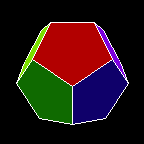

Mysticism, Spirituality, Religion
Five-fold symmetry is something of a mystical subject, with roots going way back in all kinds of folklore.
Pentagrams, the star-shaped form created by connecting the vertices of a pentagon, were used by by many ancient cultures, including the Sumerians, the ancient Greeks, and the Babylonians. They are used today by Wiccans, more commonly circumscribed with a circle.
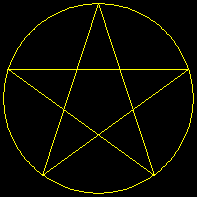
Christians once used the pentagram to symbolize the five wounds of Christ, and many neopagan beliefs incorporate the pentagram as a symbol as well. It was once used as the official seal of the city of Jerusalem.
Inverted pentagrams (i.e. with two points up and one point down) are often used by Satanists, usually in a form with double circumscription and a goat's head in the center, which is called the Sigil of Baphomet. Interestingly, the little pentagon in the center is right-side-up in the inverted pentagram.
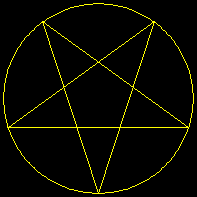
A similar symbol is also used by the Order of the Eastern Star, a group loosely related to the Freemasons that have nothing to do with Satanism.
Physics
Five-fold symmetry is somewhat of an ugly duckling in condensed matter physics (the branch of physics dealing with properties of solids and liquids). There is no way to build a regular crystal lattice, either 2-dimensional or 3-dimensional, with long-range five-fold symmetry. However, short-range five-fold symmetry has been demonstrated in structures called "quasicrystals".
Biology
Some plants and animals appear to have five-fold symmetry, like starfish, but this is a misperception. Starfish actually have left-right symmetry, like humans, but one of their tentacles is symmetric in the middle, very much like our heads. Or you could look at it the other way and say that humans and other four-extremity, one-head animals really are five-fold symmetric.
Many viruses have icosahedral envelopes. This is an image of a herpes virus.
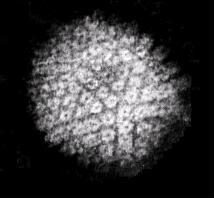
Military Applications
Any good technology must have some military application, and five-fold symmetry is no exception. In the United States military, at least, the five-pointed star has a long tradition, used to designate ranks of General or Admiral.

The highest rank in the US Army, The General of The Army, is designated by five of these five-pointed stars, arranged in a five-fold symmetric logo with a pentagon negative image in the center.

This is, however, not the highest rank in the US Military. General John J. Pershing was granted the rank of General of the Armies (note the plural), a rank intended to be superior to all other ranks in all branches of the armed forces. And George Washington, in 1976, was granted the title of General of the Armies of the United States, a rank which is superior to all other grades, past or present.
Another military application of five-fold symmetry is of course The Pentagon building.
Five-pointed stars are found on many national flags, including that of the United States, and a green five-pointed star is a symbol of Esperanto.
